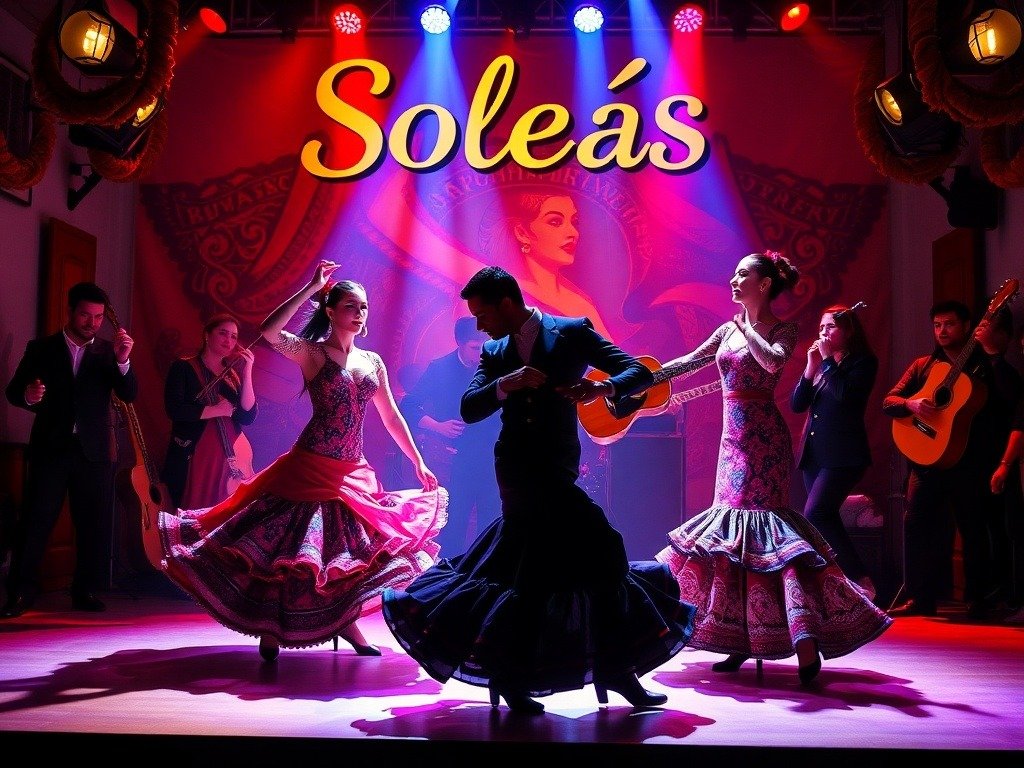
Understanding the Origins of Soleás
Soleás, a profound and emotionally rich style of flamenco, is not merely a genre of music—it is the beating heart of Andalusian soul. Rooted in centuries-old traditions of southern Spain, particularly from the provinces of Cádiz and Seville, soleás have evolved into one of the oldest and most expressive forms of flamenco singing. The term “soleá” is derived from the Spanish word soledad, meaning solitude or loneliness, which perfectly captures the melancholic and introspective spirit that defines the genre. The origin of soleás is heavily debated among flamenco scholars. Some attribute its evolution from older folk forms like tonás and seguiriyas, while others believe it arose out of the working-class struggles of the Andalusian gypsy community. Whatever its true genesis, soleás became a central pillar of flamenco performance in the 19th century, performed in taverns, plazas, and private gatherings. Its distinctive rhythm, lyrical intensity, and emotional weight make it a powerful medium for storytelling and emotional release.
Soleás as a Mirror of Human Emotion
The depth of feeling embedded within a soleá performance is unparalleled. It reflects a range of deep human emotions—sorrow, longing, regret, passion, and even spiritual awakening. These emotions are not simply portrayed; they are lived through the artist’s voice, gestures, and facial expressions. In traditional flamenco culture, singing a soleá is seen as a cathartic act, allowing both the performer and the audience to confront their internal struggles. A singer’s ability to deliver a convincing soleá depends largely on duende, a term in flamenco that refers to a mysterious and intense artistic emotion. When duende is present, the performance becomes transformative, touching something primal in every listener. This ability to reach deep into the soul is what separates a good singer from a legendary one.
The Structure and Rhythmic Pattern of Soleás
Soleás follows a strict rhythmic cycle of 12 beats, which is considered one of the most challenging flamenco rhythms to master. This compás (rhythm) is often counted as:
1 2 3 – 4 5 – 6 7 – 8 – 9 10 – 11 12
This rhythmic complexity provides the perfect backdrop for expressive freedom, enabling performers to stretch or compress phrases for emotional effect.
- The compás is cyclic and meditative, reflecting the repetitive nature of emotional pain.
- Guitarists often use syncopation and counter-rhythms to add richness and tension to the performance.
These intricate rhythmic and harmonic qualities demand immense technical mastery, especially when performed with other flamenco elements like dance and guitar.
Different Variations Within the Soleás Genre
Though soleás is often treated as a single form, it actually encompasses a wide variety of regional and personal styles. Each variation reflects different cultural nuances and rhythmic preferences.
Notable Variants of Soleás
- Soleá de Alcalá – Known for its slow tempo and heavy emotional weight.
- Soleá de Cádiz – Brighter and more rhythmic, often featuring elaborate guitar accompaniment.
- Soleá de Triana – Emphasizes vocal improvisation and raw vocal power.
- Soleá de Jerez – Incorporates a faster tempo and bold rhythmic flair.
Each variant offers unique interpretive challenges and contributes to the rich mosaic of flamenco traditions.
The Role of Guitar in Soleás Performance
The guitar in a soleá performance is far more than accompaniment; it is a co-narrator of the emotional story. Flamenco guitarists use advanced techniques like rasgueado (flamenco strumming), alzapúa (thumb technique), and picado (fast scales) to echo the singer’s emotions. The tuning and phrasing are intentionally left open-ended, allowing for improvisation and real-time emotional expression. This spontaneous interaction between singer and guitarist is what gives each performance its singular emotional intensity. Guitarists must be attuned to the singer’s breath, phrasing, and pauses, providing both rhythmic support and melodic counterpoint.
How Soleás Influences Other Flamenco Forms
Soleás serves as a foundational style from which many other flamenco forms have developed. Genres like soleá por bulería and bulerías are derived directly from the structure and rhythm of soleás but incorporate lighter moods and faster tempos.
- Soleás influence lyrical structure and phrasing in several flamenco palos.
- Even modern flamenco fusion artists often incorporate soleá motifs to lend authenticity.
By understanding soleás, one gains access to the roots of flamenco expression, making it a crucial area of study for performers and enthusiasts alike.
Soleás in Modern Flamenco and Global Impact
In recent decades, soleás has crossed borders and entered the global music scene. Artists like Camarón de la Isla, Paco de Lucía, and Estrella Morente have brought soleás to the world stage while maintaining its authentic roots. With the globalization of flamenco, soleás has found its place in fusion genres, jazz improvisation, and even classical music contexts. Despite its international reach, the essence of soleás remains fiercely local, tied to Andalusian soil and the experiences of its people. Modern artists now blend electronic elements, orchestral arrangements, and multicultural influences into traditional soleás performances, expanding its emotional vocabulary.
Learning and Teaching Soleás Today
Today, flamenco schools and conservatories across the world offer in-depth courses on soleás. These lessons cover everything from compás to vocal techniques and historical context. However, traditionalists argue that true mastery can only come from immersion in flamenco culture—listening to elders, attending juergas (flamenco parties), and living the emotions behind the music.
- Formal training teaches technique and structure.
- Cultural immersion builds emotional depth and authenticity.
For students of flamenco, understanding soleás is not just about music—it’s about embracing a way of life.
Lyrics and Poetic Themes in Soleás
Soleás lyrics are often brief, poetic, and symbolic. They reflect themes of heartbreak, loneliness, betrayal, and spiritual yearning. The verses usually consist of three to four lines, with internal rhymes and deep metaphorical language. A single verse can carry an emotional weight equivalent to an entire novel.
| Theme | Common Symbol | Example Phrase |
| Loneliness | Night, shadow | “La noche es mi compañera eterna…” |
| Love and Loss | Fire, sea | “El mar se llevó mi pena ardiente…” |
| Fate and Time | Clock, road | “Reloj sin manecillas ni destino…” |
These lyrics often carry double meanings, allowing performers to interpret them uniquely each time they are sung.
Why Soleás Remains Culturally Relevant
Even in today’s fast-paced digital world, soleás continues to resonate with audiences. Its themes of solitude, struggle, and identity are timeless. The genre’s ability to adapt while retaining its soul has ensured its survival and growth. From local festivals in Andalucía to international stages, soleás continues to captivate new generations.
- Young artists blend soleás with hip-hop, rock, and electronic music.
- Cultural preservation programs keep traditional forms alive in local communities.
Its resilience reflects the enduring human need to express pain and beauty through art.
Challenges Facing Traditional Soleás
Despite its cultural value, traditional soleás faces several challenges. The commercialization of flamenco has led to shortened performances, loss of regional variations, and diluted emotional expression. Additionally, fewer young singers are trained in the older, more challenging forms of soleás.
- Tourism-driven performances often favor flash over depth.
- Digital media promotes popularity over authenticity.
However, many flamenco aficionados and cultural institutions are actively working to reverse this trend by promoting in-depth training and community-based performances.
Soleás and Gender Representation
Traditionally, flamenco was a male-dominated world. However, women have increasingly taken center stage in performing and innovating within the soleás genre. Singers like La Niña de los Peines and Mayte Martín have brought fresh emotional perspectives and vocal interpretations. Today, gender no longer limits expressive potential in soleás, allowing for a richer artistic diversity.
- Female artists bring new lyrical themes into focus.
- Modern compositions often reflect gender-related social issues.
Their contributions continue to expand the emotional spectrum and relevance of soleás.
Spirituality and the Soul of Soleás
For many, performing or listening to soleás is a spiritual experience. The music’s haunting melodies and introspective lyrics allow for a kind of meditative catharsis. In a world increasingly focused on external achievements, soleás invites inward reflection.
- Performances often occur in candlelit settings to invoke intimacy.
- Listeners report emotional release and clarity after a powerful soleás.
This spiritual dimension gives soleás a universal appeal across cultures and languages.
The Future of Soleás in the Digital Age
As flamenco adapts to modern platforms like YouTube, Spotify, and Instagram, soleás is reaching wider audiences. However, the question remains: can digital media truly convey its emotional depth? While recordings offer accessibility, live performances remain the soul of the genre. Interactive platforms now host virtual flamenco workshops, allowing students from all over the world to study soleás, though traditionalists warn against learning without cultural context.
Conclusion: Soleás as a Living Legacy
Soleás is not just a genre; it is a living legacy of human emotion, resilience, and cultural depth. From its Andalusian roots to its global stage, it continues to evolve while staying true to its origins. Its complexity, raw power, and poetic beauty make it one of the most treasured expressions in the world of flamenco. Whether you are a seasoned performer, a music scholar, or a curious listener, exploring the world of soleás is a journey worth taking—a journey into the soul.
Frequently Asked Questions (FAQs)
1. What does “soleás” mean in flamenco?
Soleás comes from the Spanish word soledad, meaning solitude. It is a deep and emotional flamenco form that explores themes of loneliness, sorrow, and personal reflection.
2. Is soleás difficult to perform?
Yes, soleás is one of the most complex and emotionally demanding forms of flamenco. It requires a deep understanding of rhythm, vocal technique, and emotional expression.
3. Can soleás be fused with modern music genres?
Absolutely. Many contemporary artists blend soleás with genres like jazz, electronic, and rock, giving it a fresh twist while preserving its emotional intensity.






